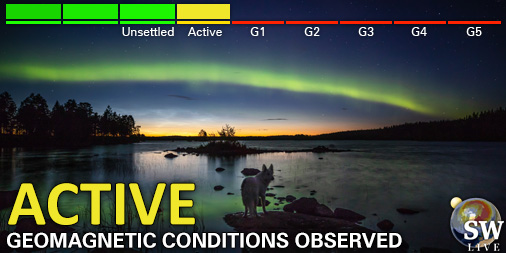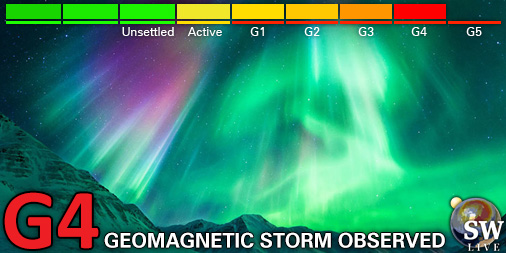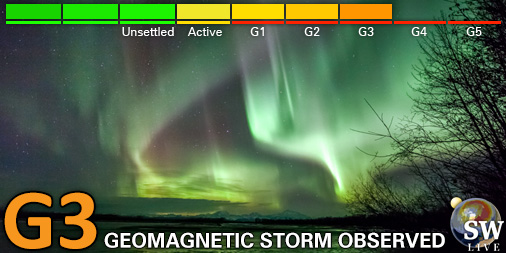Przeglądasz Archiwum z poniedziałek, 5 listopada 2001
Raport aktywności słonecznej
Przygotowane przez NOAA © SWPC i przetworzone przez SpaceWeatherLive.com
Połączenie raportów USAF/NOAA o słonecznej i geofizycznej aktywności
Numer SDF 309 wydany w 2200Z na 05 Nov 2001IA. Analiza aktywności regionów słonecznych i aktywność od 04-2100Z do 05-2100Z
IB. Prognoza aktywności słonecznej
IIA. Podsumowanie aktywności geofizycznej 04-2100Z do 05-2100Z
IIB. Prognoza aktywności geofizycznej
III. Prawdopodobieństwa zdarzenia 06 Nov do 08 Nov
| Klasa M | 80% | 80% | 80% |
| Klasa X | 25% | 25% | 25% |
| Proton | 99% | 99% | 99% |
| PCAF | in progress | ||
IV. Przepływ 10,7 cm z Penticton
Zaobserwowano 05 Nov 235 Przewidywane 06 Nov-08 Nov 235/235/235 Średnia z 90 dni 05 Nov 207
V. Indeks geomagnetyczny A
Zaobserwowano Afr/Ap 04 Nov 004/007 Szacowane Afr/Ap 05 Nov 012/015 Przewidywane Afr/Ap 06 Nov-08 Nov 060/075-030/030-015/012
VI. Prawdopodobieństwa aktywności geomagnetycznej 06 Nov do 08 Nov
| A. Średnie szerokości geograficzne | |||
|---|---|---|---|
| Aktywne | 30% | 50% | 35% |
| Słaba burza | 40% | 25% | 15% |
| Bardzo znacząca burza | 30% | 05% | 05% |
| B. Wysokie szerokości geograficzne | |||
|---|---|---|---|
| Aktywne | 20% | 25% | 25% |
| Słaba burza | 30% | 35% | 15% |
| Bardzo znacząca burza | 50% | 35% | 15% |
Wszystkie czasy w UTC
<< Idź do codziennego przeglądu
Aktualne dane sugerują, że istnieje niewielkie prawdopodobieństwo pojawienia się zorzy polarnej w następujących regionach o wysokiej szerokości geograficznej w najbliższej przyszłości
Fairbanks, AKNajnowsze wiadomości
Najnowsze wiadomości z forum
Wesprzyj SpaceWeatherLive.com!
Wielu ludzi odwiedza SpaceWeatherLive aby śledzić aktywność słoneczną lub sprawdzić czy jest szansa na zaobserwowanie zorzy polarnej. Niestety, większy ruch na stronie oznacza większe koszty utrzymania serwera. Dlatego, jeśli jesteś zadowolony ze strony SpaceWeatherLive, zachęcamy do wspierania nas finansowo. Dzięki temu będziemy mogli utrzymać naszą stronę.

Alerty
04:15 UTC - Aktywność geomagnetyczna
Aktywne warunki geomagnetyczne (Kp4) Osiągnięty próg: 03:57 UTC
02:30 UTC - Indeks mocy półkuli
Model OVATION przewiduje, że index mocy półkuli osiągnie 50GW o 03:23 UTC
środa, 16 kwietnia 2025
21:45 UTC - Aktywność geomagnetyczna
Słaba burza geomagnetyczna G1 (Kp5) osiągnięty próg: 21:36 UTC
21:00 UTC - Aktywność geomagnetyczna
Bardzo silna burza geomagnetyczna G4 (Kp8) osiągnięty próg: 20:55 UTC
19:45 UTC - Aktywność geomagnetyczna
Silna burza geomagnetyczna G3 (Kp7) Osiągnięto próg: 19:25 UTC
Fakty na temat pogody kosmicznej
| Ostatnie rozbłyski klasy X | 2025/03/28 | X1.1 |
| Ostatnie rozbłyski klasy M | 2025/04/15 | M1.2 |
| Ostatnia burza geomagnetyczna | 2025/04/16 | Kp8- (G4) |
| Dni bez plam słonecznych | |
|---|---|
| Ostatni dzień bez skazy | 2022/06/08 |
| Średnia miesięczna liczba plam słonecznych | |
|---|---|
| marca 2025 | 134.2 -20.4 |
| kwietnia 2025 | 120.5 -13.7 |
| Ostatnie 30 dni | 118.3 -22.1 |






